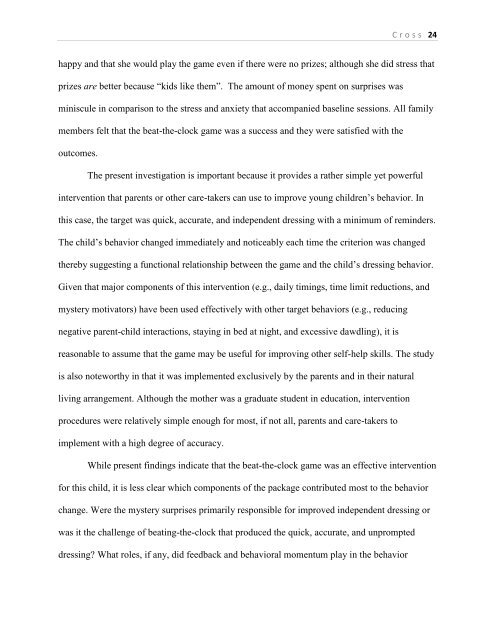THE EFFECTS OF A TIMER AND MYSTERY MOTIVATORS ON THE ...
THE EFFECTS OF A TIMER AND MYSTERY MOTIVATORS ON THE ...
THE EFFECTS OF A TIMER AND MYSTERY MOTIVATORS ON THE ...
Create successful ePaper yourself
Turn your PDF publications into a flip-book with our unique Google optimized e-Paper software.
C r o s s 24<br />
happy and that she would play the game even if there were no prizes; although she did stress that<br />
prizes are better because “kids like them”. The amount of money spent on surprises was<br />
miniscule in comparison to the stress and anxiety that accompanied baseline sessions. All family<br />
members felt that the beat-the-clock game was a success and they were satisfied with the<br />
outcomes.<br />
The present investigation is important because it provides a rather simple yet powerful<br />
intervention that parents or other care-takers can use to improve young children’s behavior. In<br />
this case, the target was quick, accurate, and independent dressing with a minimum of reminders.<br />
The child’s behavior changed immediately and noticeably each time the criterion was changed<br />
thereby suggesting a functional relationship between the game and the child’s dressing behavior.<br />
Given that major components of this intervention (e.g., daily timings, time limit reductions, and<br />
mystery motivators) have been used effectively with other target behaviors (e.g., reducing<br />
negative parent-child interactions, staying in bed at night, and excessive dawdling), it is<br />
reasonable to assume that the game may be useful for improving other self-help skills. The study<br />
is also noteworthy in that it was implemented exclusively by the parents and in their natural<br />
living arrangement. Although the mother was a graduate student in education, intervention<br />
procedures were relatively simple enough for most, if not all, parents and care-takers to<br />
implement with a high degree of accuracy.<br />
While present findings indicate that the beat-the-clock game was an effective intervention<br />
for this child, it is less clear which components of the package contributed most to the behavior<br />
change. Were the mystery surprises primarily responsible for improved independent dressing or<br />
was it the challenge of beating-the-clock that produced the quick, accurate, and unprompted<br />
dressing? What roles, if any, did feedback and behavioral momentum play in the behavior
















